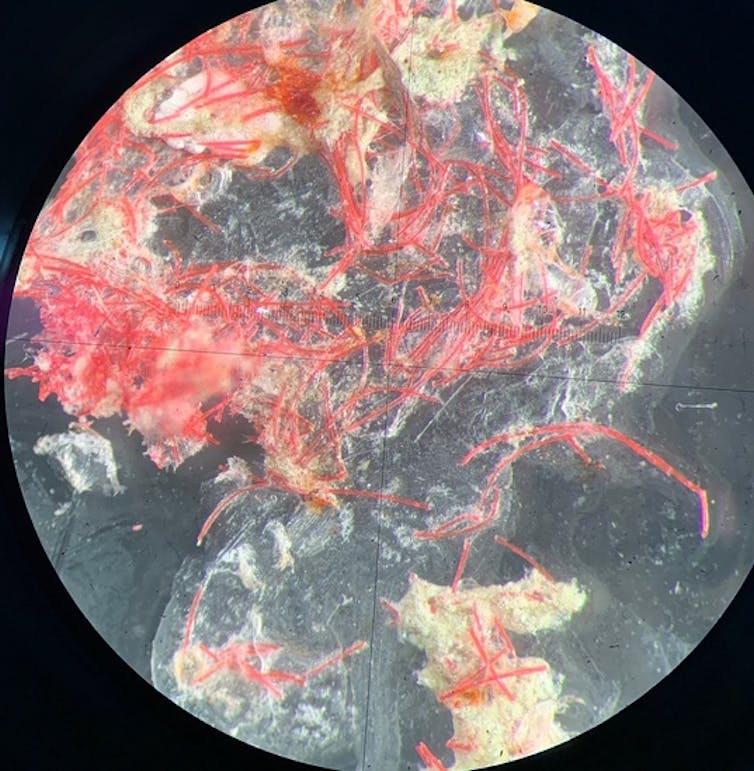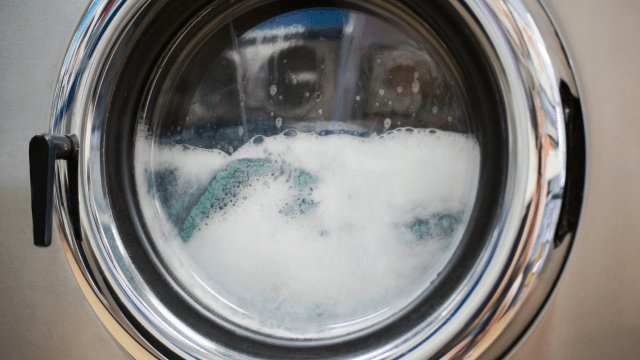Microplastics are turning up everywhere, from remote mountain tops to deep ocean trenches. They also are in many animals, including humans.
The most common microplastics in the environment are microfibres – plastic fragments shaped like tiny threads or filaments. Microfibres come from many sources, including cigarette butts, fishing nets and ropes, but the biggest source is synthetic fabrics, which constantly shed them.
Textiles shed microfibres while they are manufactured, worn and disposed of, but especially when they are washed. A single wash load can release several million microfibres. Many factors affect how many fibres are released, including fabric type, mechanical action, detergents, temperature and the duration of the wash cycle.
My research focuses on coastal ecology and water pollution, including work in New York and New Jersey marshes and estuaries that are heavily affected by human activities. Here are some things to know about reducing microplastic pollution from your washing machine.

From fabric to water and soil
Once garments release microfibres in washing machines, the fibres enter the wastewater stream, which generally goes to a wastewater treatment plant. Advanced treatment plants can remove up to 99% of microfibres from water. But since a single laundry load can produce millions of fibres, treated water discharged from the plant still contains a huge number of them.
Microfibres that are removed during treatment end up in sewage sludge – a mix of solid materials that is processed to remove pathogens. In many cases, treated sewage sludge is applied to soil as a fertilizer. This allows microfibres to enter air and soil, and to be transferred to soil organisms and up the terrestrial food web or taken up by crops.
Microplastics that wash into rivers, lakes and bays can have many harmful effects. They may be consumed by fish and other aquatic animals, affecting their biochemistry, physiology, reproduction, development or behavior. These microplastics contain chemical additives, including substances like phthalates and bisphenol A that can leach out and may have health effects in humans and animals, including effects on the endocrine system.
Textile microfibres also contain additional chemicals that have been shown to be toxic, such as fabric dyes, anti-wrinkle agents and flame retardants. In addition, contaminants that are present in the water, such as metals and pesticides, can stick to microplastic particles, turning them into a veritable cocktail of contaminants that may be transferred into animals that eat them
Washing more sustainably
Not all fabrics shed microfibres at the same rate. A loosely woven fabric that feels fluffy or fuzzy, such as fleece, sheds more than a tightly woven one. While garments made of natural fibres, such as cotton and wool, would appear to be a solution, unfortunately they also shed microfibres that can pick up pollutants in the environment.
Some textile scientists and manufacturers are developing fabrics that shed less than existing ones, thanks to features such as longer fibres and coatings to reduce shedding. Meanwhile, here are some ways to reduce microfibre shedding from your laundry:
Do laundry less often. Washing full loads instead of partial loads reduces release of microfibres because garments are exposed to less friction during the wash cycle.
Use cold water, which releases fewer microfibres than hot water.
Use less detergent, which increases microfibre release.
Use a front-loading washing machine, whose tumbling action produces less microfibre release.
Dry laundry on a clothesline. Running clothes in dryers releases additional microfibres into the air from the dryer vent.
Several types of products collect microfibres in the washer before they are released with wastewater. Some are laundry bags made of woven monofilament, a single-polyamide filament that does not disintegrate into fibres. Laundry is washed while enclosed in the bag, which traps microfibres that the garments release. A study of one such product, Guppyfriend, found that it collected about one-third of released microfibre.
Another device, the Cora Ball, is a plastic ball with spines topped with soft plastic discs that capture microfibres. It reduces microfibres by about 25% to 30%, but may not be suitable for loose knits because it can snag on threads and damage clothing.

Filter your washwater
Several brands of external filters are available that can be retrofitted onto existing washing machines. External filters can remove up to 90% of microfibres from rinse water. Their average cost is about $US150. Owners need to clean the filters periodically and dispose of the collected microfibres with other solid waste, not down the drain, which would put them back into the wastewater stream.
In a 2021 study, researchers installed washing machine filters in 97 homes in a town in Ontario, Canada, which represented about 10% of the households in the community. They found that this significantly reduced microfibres in treated water from the local treatment plant.
Some companies are now manufacturing washers with built-in microfibre filters. France has enacted a requirement for all new washing machines to be equipped with filters by 2025, and Australia has announced that filters will be required in commercial and residential washers by 2030.
In the U.S., a similar requirement was passed by the California legislature in 2023, but Gov. Gavin Newsom vetoed the bill, saying he was concerned about the cost to consumers. An economic study commissioned by Ocean Conservancy found that filters would increase the price of washing machines by only $US14 to $US20 per machine. Several states are considering regulations that would require filters in washers.
In my view, requiring manufacturers to add filters that can trap microfibres to washing machines is a reasonable and affordable step that could rapidly reduce the enormous quantities of microfibres in wastewater. The eventual solution will be re-engineered textiles, which won’t shed, but it will take some time to develop them and move them into clothing supply chains. In the meantime, filters are the most effective way to tackle the problem.![]()
Judith Weis, Professor Emerita of Biological Sciences, Rutgers University – Newark
This article is republished from The Conversation under a Creative Commons license. Read the original article.
